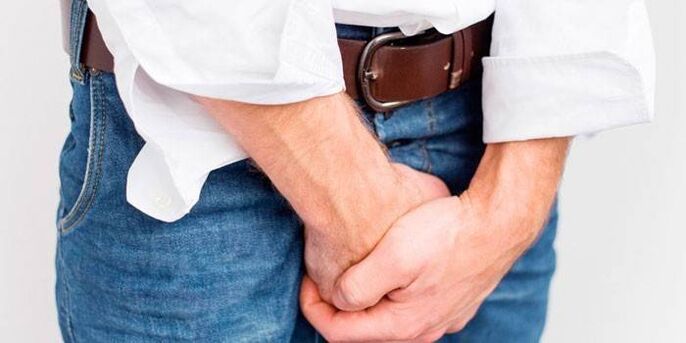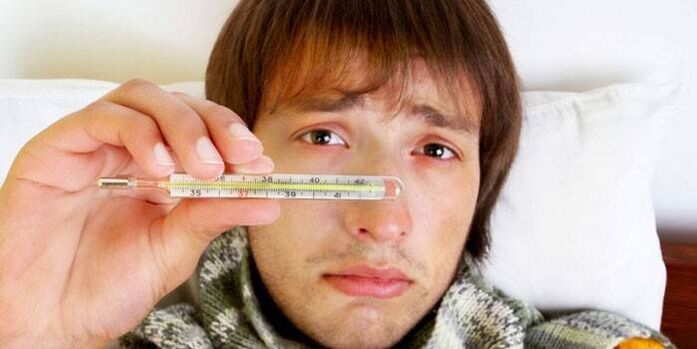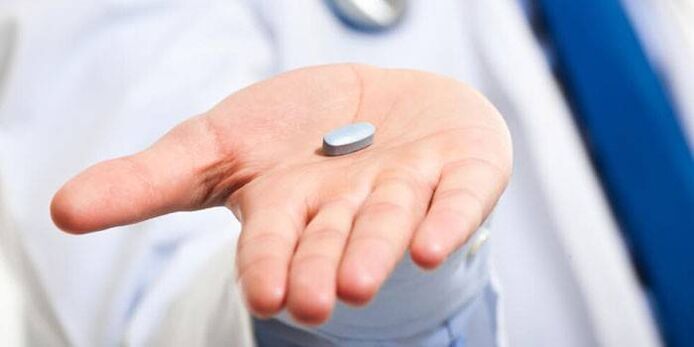Every second man of reproductive age (up to fifty years) is prone to a delicate disease such as acute prostatitis, in which under the influence of certain factors the prostate gland (prostate gland) becomes inflamed and causes various sexual disorders. functions, fertility and psycho-emotional states. Pay attention to what your body says and do not neglect timely treatment.
What is acute prostatitis
If a man feels discomfort and even pain during urination, you should see a doctor immediately, because acute prostatitis is a disease of infectious etiology that causes inflammation of the prostate, followed by edema of the glandular tissue, the formation of purulent foci. over it. If you do not pay attention to the symptoms of acute inflammation of the prostate, then the pathological process can turn into a chronic form, which is difficult to treat, and there is very little time for reflection - the transformation occurs within a few days.
However, more serious complications are possible than its chronic form. There is a risk of sepsis - a general infection of the blood and an increased urinary tract infection with the development of pyelonephritis and cystitis. In these cases, the patient is hospitalized urgently, the condition may be critical. Although sepsis as a complication is rare, it can occur in patients with immunosuppressive conditions - intoxication, fever, severe symptoms, weakness. Therefore, blood cultures are needed to detect microorganisms.
Symptoms of acute prostatitis
Every man should know and remember the symptoms of acute prostatitis. The general symptoms of the disease are:
- Acute pain when urinating.
- Body intoxication.
- Urinary disorders (intermittent, weak, intense flow).
- The desire to visit the toilet often at night.
These are external signs of prostatitis, but more in-depth examination reveals leukocytes in the urine, traces of mucus and pus in the secretory fluid of the prostate gland. During palpation, a tight, enlarged organ is felt, it will be painful to push. Further development of the inflammatory process is characterized by heaviness and pain in the perineum, radiating to the penis, sacrum and rectum. As a result, the patient has difficulty emptying the bladder and defecating due to severe pain. Body temperature can rise to 38 ° C.

Causes of acute prostatitis
Because the disease is bacterially inflammatory in nature, the causes of acute prostatitis are the following infectious agents:
- Gram-negative - Klebsiella, E. coli, Proteus.
- Gram-positive - enterococci, staphylococci, streptococci.
- Urogenital - trichomoniasis, chlamydia, ureaplasmosis, gonorrhea, candidiasis, mycoplasmosis.
The microbial microflora usually enters the prostate gland tissue transcanally (through the urethra and secretory ducts of the prostate gland). In cystitis, the infection passes from the bladder to the prostate. During endourethral manipulations (catheter placement, urethral sphincter, cystoscopy, urethroscopy), other possible routes for bacterial penetration are opened. Pathogenic microorganisms migrate to the prostate from distant pathogens in caries, sinusitis, tonsillitis, cholecystitis, pyoderma, bronchitis.
There is a high probability of infection with intestinal proctitis, hemorrhoidal cracks, colitis. Non-infectious factors that can cause an attack of prostatitis are congestive (congestive) venous phenomena in the pelvic region and impaired glandular drainage of pain. Obstruction can occur due to irregular or, conversely, excessive sexual activity, cessation of sexual intercourse, sedentary lifestyle, frequent constipation, frequent alcohol intoxication, varicose veins of the small pelvis, hypothermia.
Forms of acute prostatitis
The clinical development of this disease is considered in three stages, which are also forms of acute pancreatitis. This is:
- The first stage is catarrhal.
- The second stage is the follicular form.
- The third stage is the parenchymal form.
In men, acute prostatitis begins with catarrhal inflammation, which is characterized by enlarged pain, edema of the glandular tissue, and an increase in the size of the body. The secretory ducts of the prostate gland to the posterior urethra are actively involved in the inflammatory process. The lobules and ducts of the prostate gland become inflamed, their ability to contract is disrupted, narrowed and blocked, which can make it difficult to secrete prostate secretions.
In the catarrhal stage, the pathological process stops in the mucous membranes and does not go deeper. In the process, the disease spreads to the entire prostate gland. Follicular acute bacterial prostatitis develops. During the analysis, pus appears in the urine. The tissues of the gland change destructively, the swelling continues to increase. The follicular form is still relatively easy to treat.
In addition, a parenchymal form of the disease develops, which can result in prostate abscess, ie chronic prostatitis. Therefore, symptoms, for example:
- Increase in body temperature to 39 ° C and above.
- Manifestations of intoxication: weakness, tremors, thirst, anorexia.
- Frequent calls to the toilet for small needs are accompanied by sharp throbbing pains.
- Impossibility to empty the bladder.
- Flatulence.
- Tenesmus.
- Constipation.
- Discharge of mucus from the anus.

Diagnosis of acute prostatitis
At the first suspicion of inflammation of the prostate, hurry to the doctor. Proper and comprehensive diagnosis of acute prostatitis is very important for quick and successful treatment. The doctor will first analyze the history, when you feel pain in the perineum, whether it increases or decreases during ejaculation, urination, defecation. Be sure to ask the doctor about the patient's medical history: what diseases are transmitted, whether there are sexually transmitted infections.
The urologist will palpate the external genitalia to identify developmental pathologies, visible signs of prostatitis, and rectal examination - palpation of the prostate gland through the anus. To create a complete clinical picture, it is necessary to pass the following examinations:
- Urine analysis to determine the level of leukocytes and the presence of pus.
- Blood test.
- Culture swab - the contents of the urethra and scalp are taken to determine the growth of bacteria and their sensitivity to antibiotics.
- Determination of urine velocity (uroflowmetry).
- Ultrasound examination of the prostate gland reveals diffuse changes in the gland and the formation of its abscess.
- Blood test to determine the presence of pathogens of diseases such as syphilis, gonorrhea, mycoplasmosis, chlamydia.
- PCR diagnostics.
Treatment of acute prostatitis
After a thorough diagnosis, treatment of acute prostatitis begins. It is based on antibiotic therapy, the purpose of which is to bury infectious pathogens. In addition, conservative treatment of prostatitis includes the use of:
- Anti-inflammatory drugs.
- Means that improve blood circulation.
- Analgesics and antispasmodics.
- Drugs that support metabolic processes in the prostate.
- Multivitamins.
- Phytotherapy agents.
- Immunomodulators.
Advanced forms of inflammation of the prostate with the appearance of purulent foci require surgical intervention. Transurethral (through the wall of the urethra) or transrectal (through the wall of the anus) drainage of abscesses is performed. Surgical intervention may be required for pathological urinary retention. A puncture epicistostomy is performed - an incision is made in the abdominal cavity, a tube is inserted to direct urine.

drugs
Treatment of acute prostatitis in men with drugs (tablets, injections) is the basis of successful therapy. With proper antibiotic therapy, the infection can be eliminated within a few days. However, it is recommended to continue treatment for four weeks to achieve complete elimination of pathogenic microflora. The drugs used in the disease are:
- Etiotropic (antibiotics) - destroying pathogens.
- Pathogenetic (NSAIDs) - relieves prostate obstruction.
- Symptomatic (analgesics, antipyretics) - relieves pain, muscle spasms and other symptoms.
To treat prostatitis, your doctor may prescribe a combination of medications that include:
- Injections - help the drug to penetrate the tissues of the body in a short time.
- Candles (rectal) - have analgesic, antibacterial effect.
- Instillation - delivery of the drug to the prostate through the opening of the urethra.
- Microclysters with herbal decoctions.
- Broad-spectrum antibacterial drugs, unless a specific causative agent is identified.
Antibiotics for acute prostatitis
The main cause of prostatitis are pathogenic bacteria that cause inflammation in the tissues of the prostate gland. Therefore, antibiotics for acute prostatitis are the basis of treatment and are prescribed only after testing the sensitivity of the microflora. Antimicrobials used for inflammation are divided into the following groups:
- Fluoroquinolones.
- Penicillins.
- Cephalosporins.
- Macrolides.
- Tetracyclines.
- Aminoglycosides.
Prevention of acute prostatitis
It is important to prevent acute prostatitis so that a man is always healthy and full of energy, including:
- Regular sex life with a regular partner, except for casual relationships.
- Use of condoms.
- Stop smoking, drugs, alcohol.
- Proper nutrition.
- Personal hygiene.
- Annual preventive examinations at the urologist.
- Taking vitamins and zinc supplements.
It is important to completely treat diseases of the genitourinary system (urethritis, cystitis, pyelonephritis, balanoposthitis). Untreated diseases can lead to the development of inflammatory processes in the prostate gland. Among other things, we must not forget to increase physical activity. Hypothermia should be avoided in the cold season. Prostate massage is very useful for men's health. However, if the disease is already felt, massage is contraindicated and even impossible due to pain in the body.



























